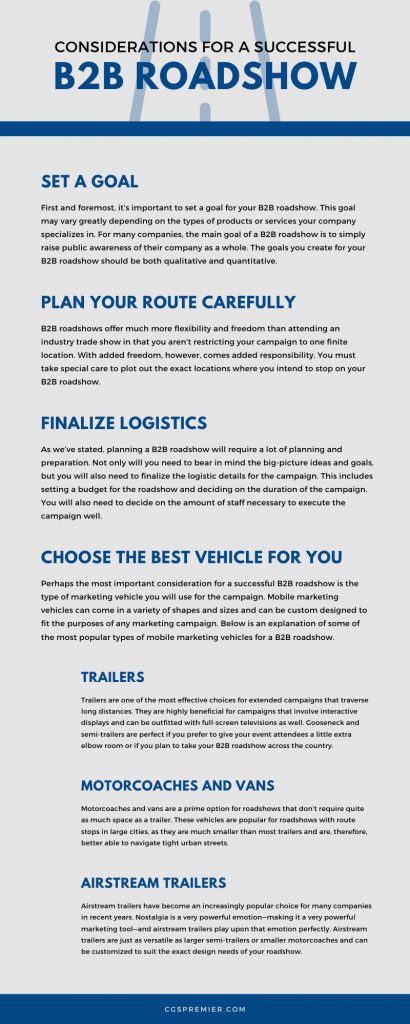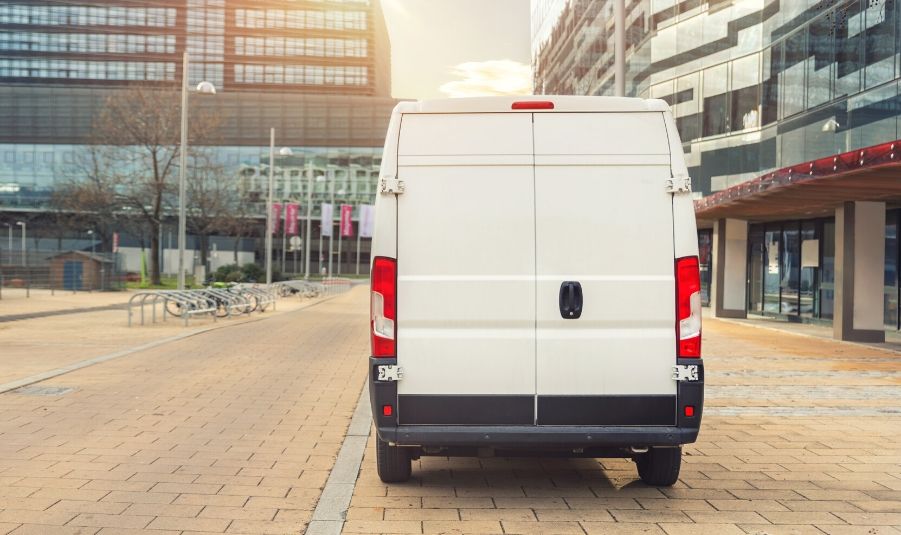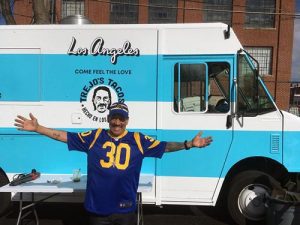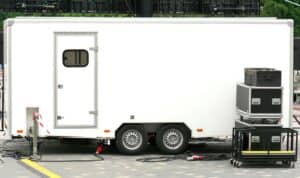Attending a trade show can be a great way to increase your brand’s visibility, but it may not always be the most profitable addition to your company’s current marketing strategy. In times when attending a trade show simply isn’t in the cards, consider taking your show on the road with a B2B roadshow instead. Sometimes also referred to as a mobile trade show tour, a B2B roadshow allows a company to take its products and services directly to consumers, rather than waiting to attend a convention or trade show. Like any marketing campaign, a B2B roadshow will require a significant amount of planning and organization. This guide will explore various considerations for a successful B2B roadshow to ensure that your campaign goes off without a hitch.
Set a goal
First and foremost, it’s important to set a goal for your B2B roadshow. This goal may vary greatly depending on the types of products or services your company specializes in. For many companies, the main goal of a B2B roadshow is to simply raise public awareness of their company as a whole. The goals you create for your B2B roadshow should be both qualitative and quantitative. Quantitative goals may refer to the number of attendees at every event location or the number of customers’ contact information you gather. Qualitative goals, on the other hand, may be a bit harder to set and calculate. Conducting field research at your events will help put you on the right path toward gathering beneficial qualitative data. The goals you set will help determine the course of your B2B roadshow as a whole. It will impact many of the decisions you make throughout the course of your roadshow, so it’s important to spend ample time setting your goals and the metrics with which you will measure progress toward those goals.
Plan your route carefully
B2B roadshows offer much more flexibility and freedom than attending an industry trade show in that you aren’t restricting your campaign to one finite location. With added freedom, however, comes added responsibility. You must take special care to plot out the exact locations where you intend to stop on your B2B roadshow. Choosing locations at random will cause your entire campaign to become muddled and disorganized and will likely confuse the consumers who hope to attend your events. When plotting out stops on your route, try to choose locations that will appeal to members of your target demographic. Consider the age and background of your key audience, and organize your route accordingly. For instance, if your company targets working adults and commuters, consider creating a route that stops in all the largest metropolitan areas in the country. This ensures that your display will be seen by the right people, thereby furthering the success of the event as a whole.
Finalize logistics
As we’ve stated, planning a B2B roadshow will require a lot of planning and preparation. Not only will you need to bear in mind the big-picture ideas and goals, but you will also need to finalize the logistic details for the campaign. This includes setting a budget for the roadshow and deciding on the duration of the campaign. You will also need to decide on the amount of staff necessary to execute the campaign well. Slightly overstaffing may seem like a good way to ensure all your bases are covered, but it will likely lead to a little bit of added chaos. Too many cooks in the kitchen is never a good thing, after all. Staff your roadshow with the best of the best, choosing only a select few trusted employees to join you on the road. This will help keep things from becoming muddled and will ensure that you always have the best people on hand during the campaign.
Choose the best vehicle for you
Perhaps the most important consideration for a successful B2B roadshow is the type of marketing vehicle you will use for the campaign. Mobile marketing vehicles can come in a variety of shapes and sizes and can be custom designed to fit the purposes of any marketing campaign. Below is an explanation of some of the most popular types of mobile marketing vehicles for a B2B roadshow.
Trailers
Trailers are one of the most effective choices for extended campaigns that traverse long distances. They are highly beneficial for campaigns that involve interactive displays and can be outfitted with full-screen televisions as well. Gooseneck and semi-trailers are perfect if you prefer to give your event attendees a little extra elbow room or if you plan to take your B2B roadshow across the country. Trailers of any size can be custom made to fit the exact design vision for your unique B2B roadshow, from cabinet hardware to electrical enclosures to smart technology.
Motorcoaches and vans
Motorcoaches and vans are a prime option for roadshows that don’t require quite as much space as a trailer. These vehicles are popular for roadshows with route stops in large cities, as they are much smaller than most trailers and are, therefore, better able to navigate tight urban streets. Like trailers, motorcoaches and vans are fully customizable, so you can outfit them with a variety of different technological equipment and interactive opportunities for consumers. Motorcoaches and vans are also a popular option for companies that are looking to take their roadshows right to their consumers’ doorsteps. Setting up shop in your customer’s parking lot will put your company at the forefront of their mind and will help increase attendance within your target demographic.
Airstream trailers
Airstream trailers have become an increasingly popular choice for many companies in recent years. Nostalgia is a very powerful emotion—making it a very powerful marketing tool—and airstream trailers play upon that emotion perfectly. Airstream trailers are just as versatile as larger semi-trailers or smaller motorcoaches and can be customized to suit the exact design needs of your roadshow. They can travel both long and short distances with ease and are a great option for marketing campaigns of any size.





